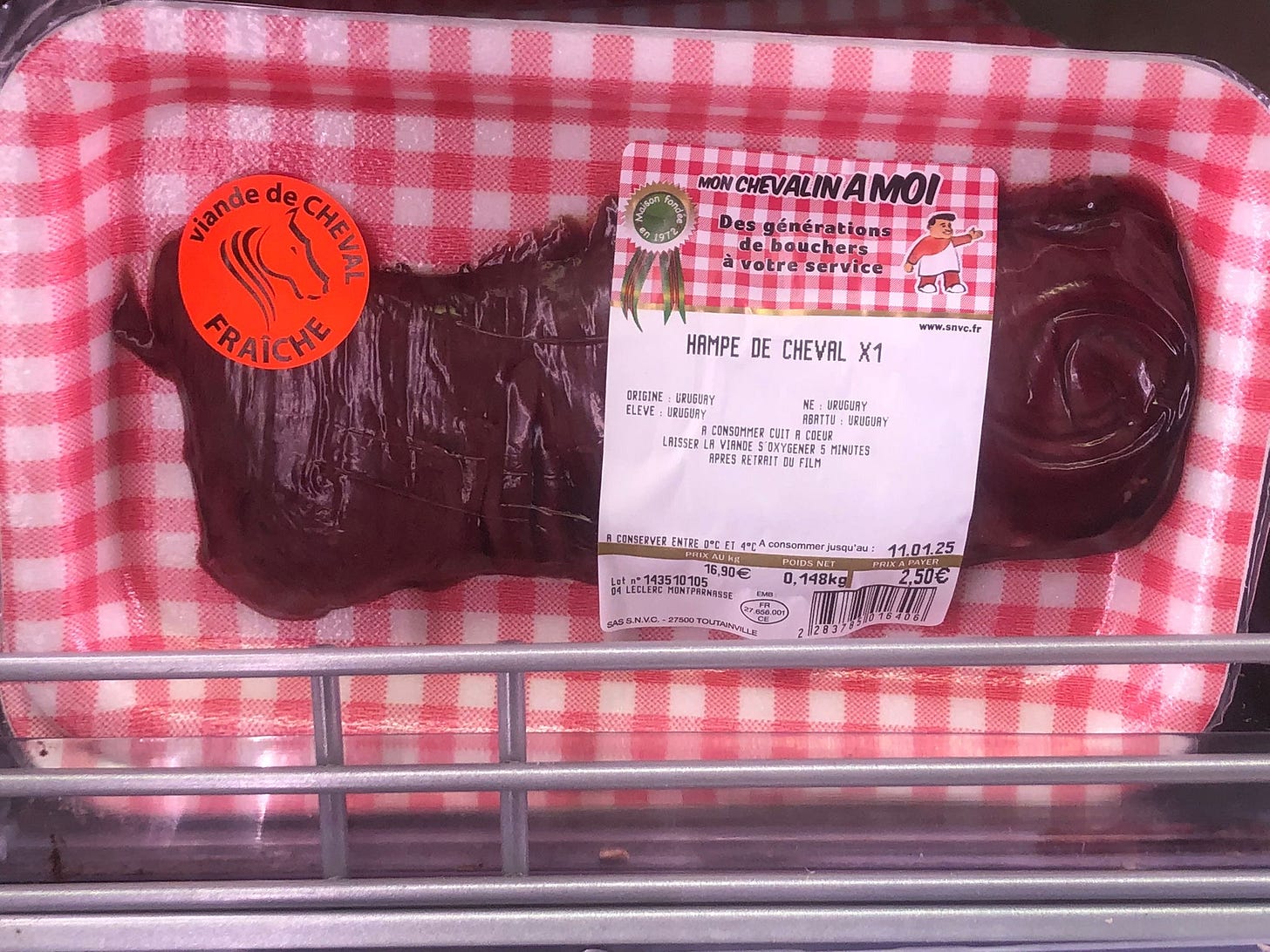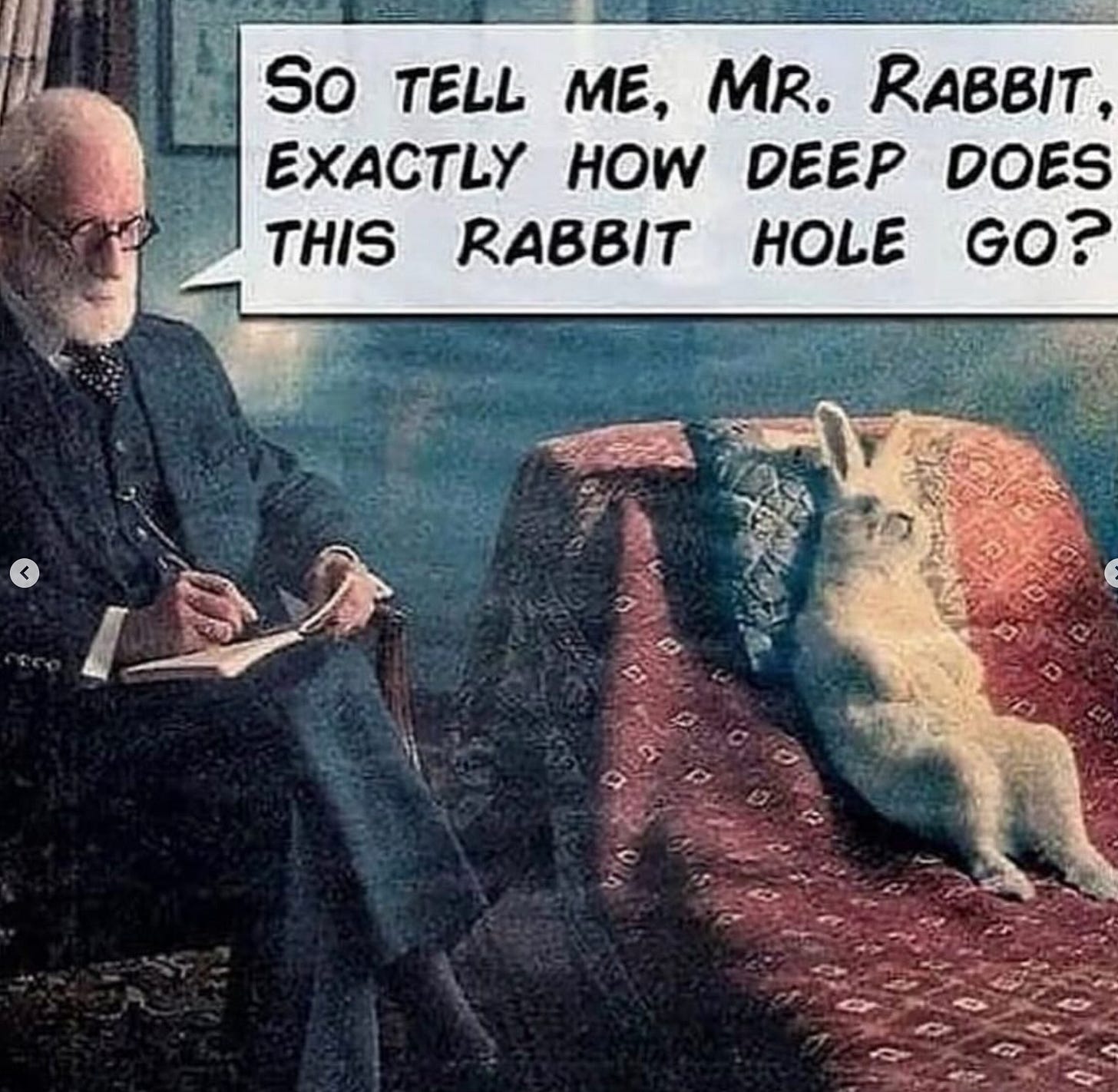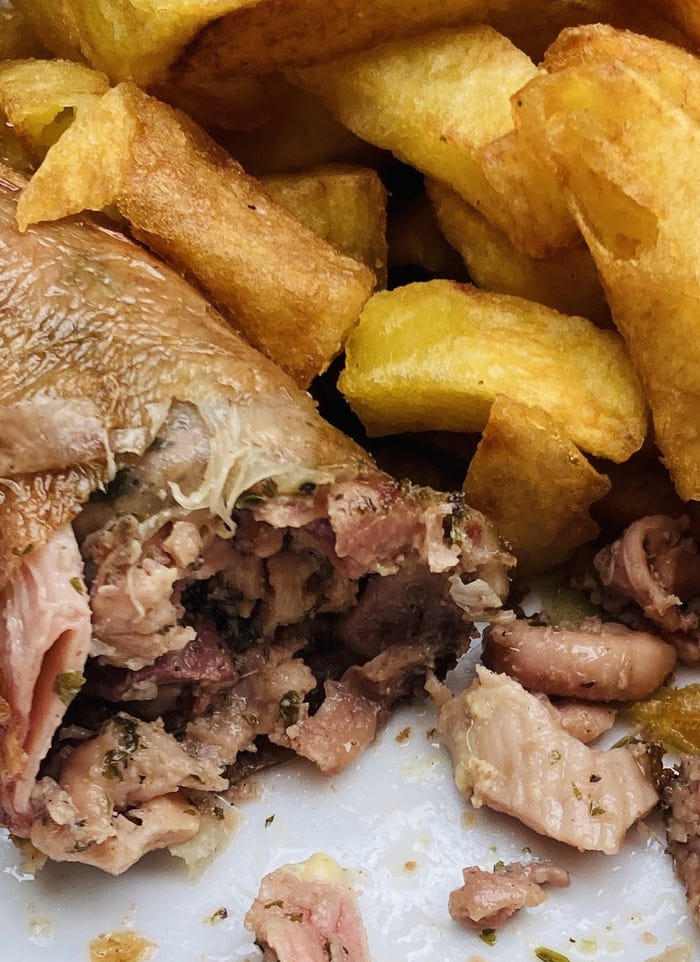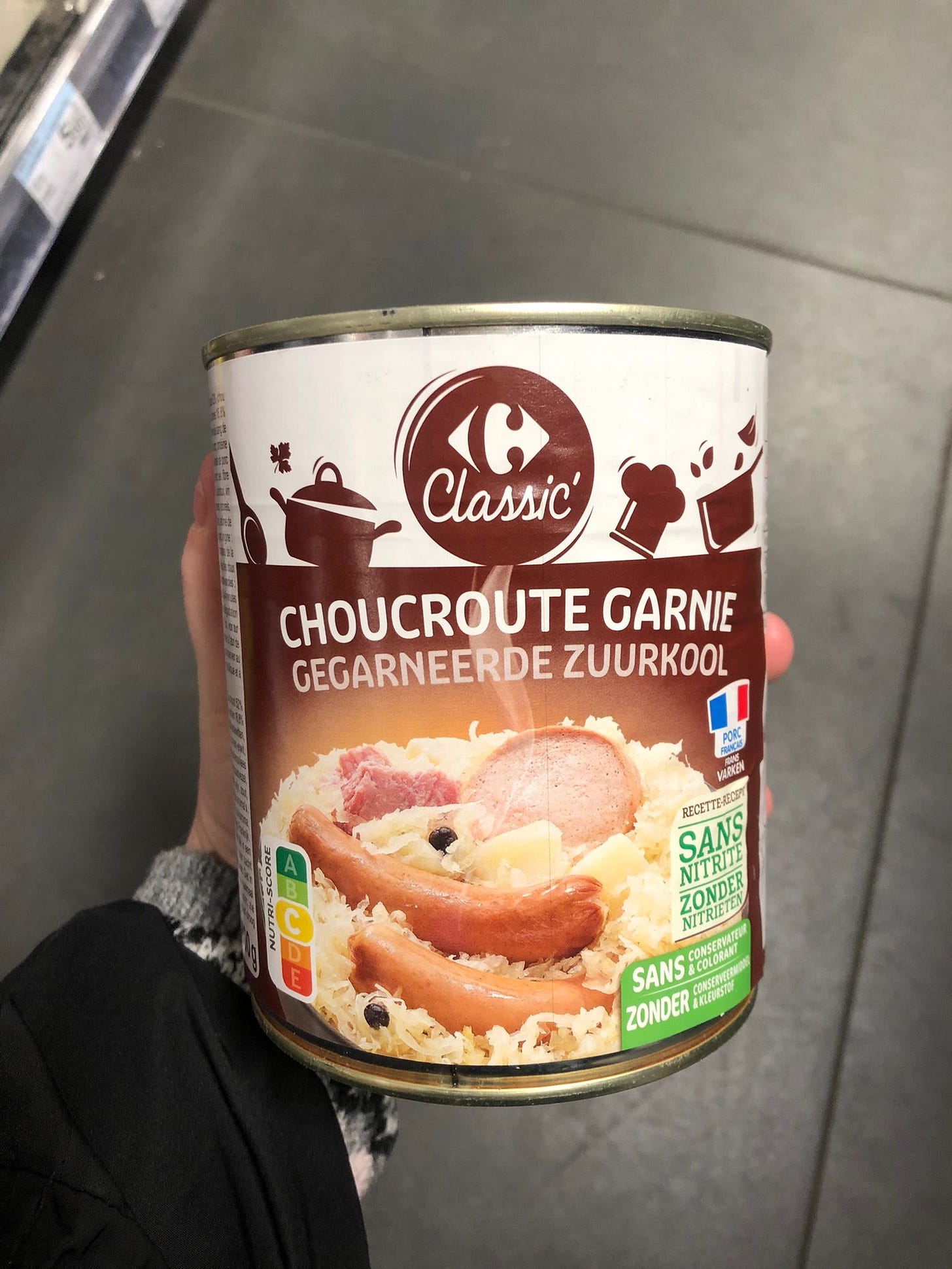Are you jump-curious when a rabbit hole appears? Do you get a little charge when you feel heroic, and take a huge leap onto the unknown, and live to tell the tale, and receive adulation from “simple” folks who don’t seem to display any signs of courage or elan? “I’m bold. One-of-a-kind,” you might say as you dust a chip off your shoulder for your superior stance in willing to take on higher teachings for the rest of us. You might austerely live in a cave for seven years, meditating on behalf of humanity. Or, you might be more prone to enter a plant-medicine ceremony that surely will lead to Biblical-level revelations, and that will be monetized in your next online masterclass.
Oh, how delicious to know more than others! To be the tall poppy. The martyr. To become the teacher to the simple souls that seek you out for being the exceptional being who discovered the secrets of life!
Then again, you might be more in tune with your “shadow side” and be drawn to the sadistic charge of an obnoxious life-lesson and the state of disarray in which it leaves you. You jump in with the hope that life slaps you silly, because you know the jolt will be followed by an addictively delicious sense of calm and peace. Never mind about any long-lasting repercussions. In Existential Kink, Dr. Carolyn Elliott clarifies this weird, little paradox in which we seek out situations that hurt so good: we might get a huge charge by the sweet agony of failure, shame, pain, and suffering. We might crave this more than we are willing to admit.
I am jump-curious, as I crave the aftereffects of a good life-lesson where softness and peace seem to take over my nervous system. Every hole I’ve jumped into (by choice, or by kicking and screaming) has led to a sense of “okey-ness” with not knowing absolute answers to agonizing questions. Each brought more play, laughter, and gratitude to my days.
The more trips I take, the more my mind expands, the less I feel the need to give unsolicited advice, the more I laugh at myself, the more I relax, and the more I just want to ignite every pleasure receptor in my body to enjoy the ride.
The more I jump, the more I want to hear of others’ wild rides. Not to compare, but to coat-tail off each other and simply enjoy a shared sense of play.
Frolicking in the kitchen I feel the pull of my inner muse to play and manifest something new out of the abyss. An ugly, stinky cabbage, for instance, can alchemize into sweet, elevated umaminess in my hands. It’s a playful rabbit hole to behold the wrinkly crucifer and imagine how much I will need to litigate for the finished dish with picky eaters, skeptical dinner guests, and displeased neighbors on my floor who will surely comment on the grotesque smell diffusing from my apartment when we meet on the elevator tomorrow morning.
I’m game… I have it in me to see this to the end and birth something playful and delicious with a stinky brassica. It’s not the trouble it will bring me that satisfies (in an Existential Kink sort-of-way), but the instinct within that tells me to push, push, push — birth something interesting! Go off, and create!
If the itch to play seduces you into experimentation, you’ll do just about anything to see where it goes: a new lover? a huge wave to surf? a totally whacky new invention? You won’t scratch that itch ‘til you jump into that rabbit hole and embody the archetype of the mad inventor that in a fully dissheveled state (emotional and/or physical) conceives the extraordinary.
A CULINARY RABBIT HOLE
To eat the entrails, and organs, and the viscera of animals would be the most intolerable taboo to almost everyone I have met in my entire life in every country I’ve ever lived in (seven so far) or visited, except for Argentina, Uruguay and France. The butcher’s case is usually very pretty in the Anglosphere, where little packets of beef are wrapped in filo dough and adorned with long blades of chive tied into pretty little bows. Anything, it seems, to avoid the seemingly excruciating reality that we are about to partake in the eating of dead flesh.
Not so in Paris, where calfs’ brains, and tripe, and pigs’ heads are proudly on display at market every Saturday morning. Where vegans are often understood to be chicken-eaters, and in no way have the same opportunities for delighting in Parisian deliciousness as carnivores. Where how one eats their meat is a clear demarcation between the locals and the foreign weaklings who cannot seem to handle a plate of raw beef, or medallions of bull’s tongue a la vinaigrette.
My shadow self comes to full light at my favorite bistros where I dine not to confront my relationship to dead, edible flesh, but where I come to terms with my humongous ego and a disturbing little tendency toward the performative. My habit is to order the andouiellete sausage (with its sinews, and chewy parts, and funky stench) and to delight in the adulation that the waitstaff impart on me as they realize that I’m not some feeble foreigner with an underdeveloped palate who cannot tolerate elevated culinary experiences.
Vous le connaissez? a waiter might ask with furrowed brow.
Of course I know what I’m ordering: sinewy guts with the remnant stench of bovine digestive juices. The waiter smiles at me approvingly. I had him at “andouiellete,” it seems. I sense a turning point in my meal, and I just know I’ve been let into the exclusive club of locals who sneer at the bewildering culinary immaturity of Americans and Australians (et. al.). An unhealthy rush of pride overtakes my good senses, and I might even engage in some mutal eye-rolling with my server as we discuss the mystery of these culinary ingenues and their self-imposed limitations. I’m gossiping with the server, exchanging more words than usual (for me) with a local who seems to approve of my individuality and eclectic nature. I triangulate against my own with a complete stranger who went from arrogant to chummy in a matter of seconds, and I now have a best friend, a comrade, a partner in crime with whom I will exchange smiles, smirks, and eye rolls as we realize that we concur that, indeed, those ingenues on the outside have absolutely no taste.
As an anti-gossip-kinda-gal, I’m appalled at the immense satisfaction these interactions bring me. And, I’m ashamed to admit, I’ve sought them out quite often in a guilty pleasure sort-of-way. Gossip and idle chit chat are toxic for me (for everyone?), and yet here I am seeking out this dark force that satisfies, if only for a few minutes.
The liminal space that I navigate in this city, where my atrocious French and perpetual smile are a dead giveaway of my outsider status, melts away during these lunches. My back is erect, my chest puffs out like a pigeon in heat, and for a few minutes I belong. Never mind I have to sell my soul (and my compatriots)… I’ll talk it out in therapy and my Existential Kink book club.
For some, it’s the dead flesh that brings out those pesky little questions about the shadow-self. For me, it’s the shallow, toxic, underhanded seediness of joining an imaginary club that, for a moment, makes me feel like I won’t be expelled from this magnificent city by sneering locals and the oh-so-chic. I am much more vacuous (sometimes) than I’d like to admit.
For the not-so-shallow, the partaking of dead bovine guts is where the shadow self must be explored. I’m endeared to the ones who, even in France proper, have taken it upon themselves to ask more beautiful questions about how we live our lives. How can we maintain our purity as higher beings if we engage in the killing of beasts for consumption? Is how we eat an act in the service of the deities? Can we thrive without destroying lives and come into contact with our divine self? Fantastic conversations that would serve me much better than idle gossip with chummy waitstaff.
A good conversation with a Cathar, had I been a French woman in the 1200s, would have been delightful. The Cathars lived in the Languedoc region of modern France and were active vegetarians in the service of the gods. They engaged in purity and fertility rituals from nudity to vegetarianism. As a probable offshoot of the ancient Cult of Isis, the Cathars invoked the powers of the fertility Goddesses in ritual purifications that invoked rebirth experiences in which doorways to hyperdimensions could open. They were unmanageable by the church hierarchy, and Pope Innocent III ordered all of them killed (along with any neighbors who might happen to be near). Perhaps up to 100,000 were executed, burned, or beheaded. No tolerance would be shown to the counter-culture in those days, and traditionalism would reign through deadly force.
A very dark period in which the French were forced to stick to certain traditions, or else….
In 2025, no one is forced to eat meat any more (and nudity is embraced at the Bois de Vincennes in Paris), but no major focus can be noted in exploring the shadow side of how we eat here. Perhaps the iron rule of the church triumphed? Perhaps deep hunting and animal husbandry traditions dominate the culinary landscape? Perhaps the cuisine of the peasantry, with its “off cuts” and hearty ingredients are just too good to pass up. Whatever the origins of this unyielding carnivorous love affair, what is certain is that the French honor the kill by consuming the entire animal without apology.
There is no waste. The entrails, the guts, the brains — it’s all alchemized into a richness of flavor that soothes and satisfies at Sunday lunch, or during a weeknight dinner of spinach-calf’s brains ravioli with a sage-butter sauce (you heard me!). Whereas in the US, we’d rather feed these “unthinkables” to our cats and dogs I assert that we honor the natural world when these cuts make it to our tables, and we truly enjoy them.
The andouiellete is a delight for the senses. It’s crispy outer skin satisfies the need for caramelization. The insides are a bit chewy and toothy: some bits are gelatinous, others have the texture of well-cooked cartilage. The scent is unmistakably visceral — some would call it a funky stench, others a deep primal pungence that makes its mark and pronounces our connection to our hunter-gatherer ancestors.

I still haven’t tried the locally-revered horse meat. In some form of shadow-play, my unease with killing to survive surfaces, and the meat-loving hippocrite in me asks how such a beautiful animal could be eaten?! And then a deluge of questions floods my mind and heart: Are cattle less valuable than horses? If I love meat so much, would I be willing to hunt it myself? How come every time I’ve gone fishing, I got a cold chill when I whacked the fish on the head to put it out of its misery? Should I be drinking this delicious milk, if dairy farms are notorious for slaughtering baby calfs? If my husband hunts a rabbit for dinner, will that mean that the baby bunnies who were expecting their mama’s return that afternoon will be orphaned and eaten by local raptor owls? Is this good for the owls? But, what about plants … research is finding that they may be sentient too. As Terence McKenna once said, after being asked if he was a vegetarian: “the most intelligent beings I have ever met are plants, so why shouldn’t I eat meat?”
And amongst this disorienting vortex of doubts and queries, I still go to market and bring home a beef tongue, or a thick slice of head cheese to eat with plenty of lemon juice. And I cook meat every day with absolute delight. And in the middle of winter, like so many, I pine for hearty stews and hefty flavors. In Paris, an enormous homage to winter meat is the choucroute garnie that stems from the Alsace region bordering Germany. The dish is a hearty stew of saurkraut, various cuts of smoked and fresh meats, potatoes, juniper berries and other spices. Deep Northern European winter fare of which many a variety exist. Kopusta, from North-eastern Europe, for instance, is very similar and was a favorite in my home growing up where Aunt Anastasia’s famous feast for dozens would be brought to life with caraway seed, pork knuckles, and added sour cream.
A beloved dish here in France, even the supermarkets sell “heat and serve” cans of choucroute. I prefer to make my own, invoking Anastasia’s Lithuanian techniques, but keeping the juniper berry. On a whim, I bought whatever cuts I could find recently, and made a beautiful batch that lasted through the entire weekend. It brought back memories of enormous hugs and giggles in Anastasia’s kitchen, and the deeply recognizable scent of my childhood home as pots of kopusta/choucroute would simmer at the stove for hours. Times when big questions and the shadow self had not yet surfaced in my life, when good food and loving company meant everything. Whatever the name (choucroute, kopusta, etc.), this dish is for Anastasia — the vivacious, delightful great auntie who loved life unconditionally and who brought her big heart and spirit to the New World (and who cut off her long hair and threw her luggage overboard en route to America at age 16 ♥️). Bon Appétit, Ana. And bon appétit to you, dear reader, as you cook your way through deep winter.
ANASTASIA’S CHOUCROUTE
Ingredients (all measurements are approximate… this is a very liberal dish):
-3 large onions, sliced
-4 tablespoons of butter
-1.5 cups of white cooking wine (I used chardonnay)
-2 cups of chicken stock. You can use bouillon cubes if you don’t have time to make your own stock.
-a dozen juniper berries, 2-3 medium bay leaves
-1.5 tablespoons of salt (and more to taste)
-2.5 pounds (1.25 kilo) of ready-made saurkraut: look for products without additives or vinegar
-2 pounds (1 kilo) of smoked meats: you can use any combination of smoked bacon chunks, pork knuckles, ham hocks, smoked sausages, etc.
-10 beef hot dogs cut in half (or pork, if you prefer)
-4-6 well-marbled pork chops, or 1/2 dozen fresh, all-meat sausages of any kind (not-smoked)
-1.5 pounds (750 grams) of well-marbled pork belly, cut into 2 inch squares
-1/2 dozen boiled potatoes, cut into chunks
-sour cream
Method:
This is a very forgiving recipe. Don’t get too caught up with precise measurements of meats and saurkraut. But do remember that this needs to have a beautiful, smoky, tangy flavor.
- In a very large dutch oven (or soup pot), melt the butter on low heat. Add the onions, and sweat them for 5 minutes until they begin to soften. Do not caramelize.
-Increase heat to high, and add the wine. Boil for approx. 1 minute.
-Lower the heat to low, and add stock, saurkraut, juniper berries and salt. Simmer for 5 minutes, stirring occasionally.
-Place all cuts of smoked meats onto the saurkraut. Stir gently, and push the bay leaves onto the surface of the saurkraut (also, very gently).
-Simmer, stirring occasionally, for 3 hours. Or cook in a very moderate oven (140C/275F), stirring occasionally, for the same amount of time.
-Add fresh cuts of meat: I used all beef sausages, but pork chops are delightful here. Gently push into the saurkraut. Continue simmering/cooking for another hour.
-Remove from heat, and let choucroute rest for 20-30 minutes. Adjust salt to taste.
-Serve with warm, boiled potatoes, and spoonfuls of sour cream (3 spoonfuls per plate for me).
Refrigerate any leftovers, and ensure you have good white bread around for sandwiches the next day (if you love hot dogs with saurkraut, you’ll understand what to do here). Ensure you have a good mustard for this. Happy winter cooking.










Share this post